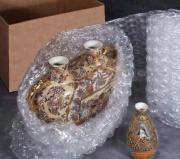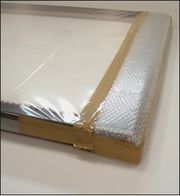Difference between revisions of "Bubble wrap"
| Line 18: | Line 18: | ||
== Applications for Storage Exhibit and Transport == | == Applications for Storage Exhibit and Transport == | ||
| − | |||
* Packing and cushioning material with interleaving tissue | * Packing and cushioning material with interleaving tissue | ||
* For short-term transport, such as in field kits | * For short-term transport, such as in field kits | ||
Revision as of 13:45, 3 November 2018
Description
Introduced in 1960 as a trademark of Sealed Air Corporation, Bubble Wrap was formed from a double layer of plastic film containing sealed bubbles, or air pockets, between the layers. The bubbles provide cushioning and are often used to provide some shock and vibration isolation Bubble wrap is typically made from Polyethylene films, but some brands may be composed of Polyvinylidene chloride or Polyvinyl chloride. The permeability of the film can result in deflation of the bubbles overtime. Some versions, such as Aircap@ [Sealed Air] and Polycap@ [Ipsind] have and additional layer of nylon that prolongs the lifetime of the bubble. Maximum cushioning is provided with the bubble side toward the object, however, direct contact with the film may leave marks and sharp edges may break bubbles. Some of the problems can be mitigated by placing two bubble layers face-to-face.
Synonyms and Related Terms
Bubble Wrap@; Bubblewrap; bubble-wrap; Artifact bubble wrap; bubble pack; bubble paper; air fill; Air Cap; Polycap; Luftpolsterfolie (Deut.)
Forms and Sizes
Bubble wrap is usually sold as rolls with widths up to 72” wide. Bubble sizes can range from 1/4” to 2“ diameter; typically 3/16”, 5/16” and ½”. Perforations optional (e.g. every 12”). It is available in versions that are:
- antistatic
- sticks to itself
- flat films on both sides
Applications for Storage Exhibit and Transport
- Packing and cushioning material with interleaving tissue
- For short-term transport, such as in field kits
Cautions
- Not for use in long-term-storage
- Bubbles may deflate over time
- Poly(vinylidene chloride) and Poly(vinyl chloride) films may release hydrochloric acid
Additional Information
Bubble Wrap history: https://web.archive.org/web/20100923074021/http://www.bubblewrapturns50today.info/bubble_wrap_facts.pdf
Sealed Air products: http://www.sealedairprotects.com/eu/en/products/bubblewrap/bubble_wrap.aspx
Sources Checked for Data in Record
- Preparation, Art Handling, Collections Care Information Network (PACCIN): website http://www.paccin.org/content.php?62-Materials
- Marjorie Shelley, The Care and Handling of Art Objects, The Metropolitan Museum, New York, 1987
- Pam Hatchfield, Pollutants in the Museum Environment, Archetype Press, London, 2002
- Random House, Webster's Encyclopedic Unabridged Dictionary of the English Language, Grammercy Book, New York, 1997
- The American Heritage Dictionary or Encarta, via Microsoft Bookshelf 98, Microsoft Corp., 1998

